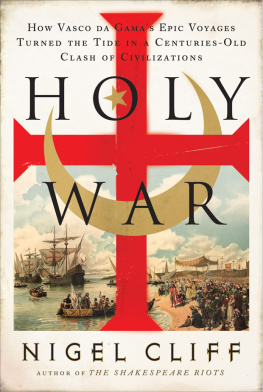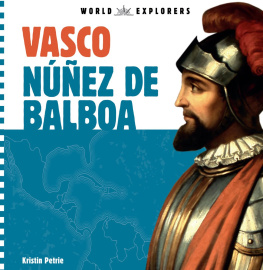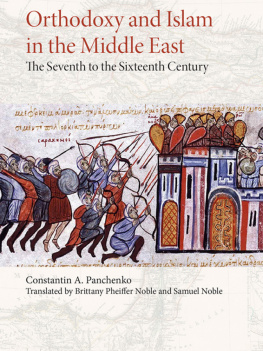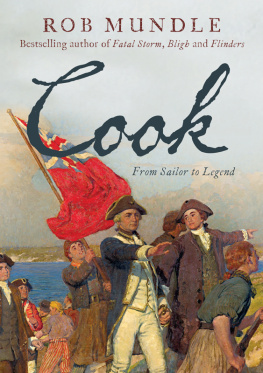HOLY WAR
H OW V ASCO DA G AMAS E PIC V OYAGES
T URNED THE T IDE IN A C ENTURIES -O LD
C LASH OF C IVILIZATIONS
NIGEL CLIFF

For Viviana
Contents
1. North Africa from the Catalan Atlas of 1375 by Abraham Cresques (Bibliothque nationale de France)
2. The world according to a Catalan map of c. 1450 (Biblioteca Estense, Modena)
3. Three representatives of the Monstrous Races, illustration by the Matre dEgerton from Marco Polos Livre des Merveilles , c. 141012 (Bibliothque nationale de France)
4. Henricus Martelluss world map of 1489 (The British Library)
5. The 1453 siege of Constantinople, illustration by Jean Le Tavernier from the Voyage dOutremer by Bertrandon de la Broquire, c. 1458 (Bibliothque nationale de France)
6. Henry the Navigator, from the mid-fifteenth-century Polytriptych of St. Vincent by Nuno Gonalves (Museu Nacional de Arte Antiga, Lisbon)
7. Miniature of Manuel I, from the Leitura Nova of Alm-Douro, 1513 (Arquivo Nacional da Torre do Tombo, Lisbon/Bridgeman Art Library)
8. Wedding portrait of Isabella I of Castile and Ferdinand II of Aragon, c. 1469 (Convento MM. Agustinas, Madrigal de las Altas Torres, vila/Bridgeman Art Library)
9. Portrait of Vasco da Gama (Sociedade de Geografia de Lisboa)
10. The So Gabriel , from the Memrias das Armadas of 1568 (Academia das Cincias, Lisbon/Bridgeman Art Library)
11. Sixteenth-century mural from the Veerabhadra Temple, Lepaskhi, Andhra Pradesh (SuperStock)
12. The Cantino Planisphere of 1502 (Biblioteca Estense, Modena)
13. The Santa Catarina do Monte Sinai , circle of Joachim Patinir, c. 1540 (National Maritime Museum, Greenwich)
14. Portrait of Vasco da Gama, c. 1524, school of Gregrio Lopes (Museu Nacional de Arte Antiga, Lisbon)
15. Lisbon in 1572 from the Civitates Orbis Terrarum by Georg Braun and Franz Hogenberg (Heidelberg University Library)
16. The Portuguese in Goa, late sixteenth-century engraving by Johannes Baptista van Doetechum from the Itinerario of Jan Huygen van Linschoten (Bridgeman Art Library)
T HIS STORY SPANS three continents and more centuries, and most of the people and places in it have been known by different names, at different times, and in different languages. Fittingly perhaps, Vasco da Gama has never been rechristened; I give his family name as Gama in the Portuguese manner, though some historians have preferred da Gama or Da Gama. In most casesnot least that of Gamas great rival, born Cristoforo Colombo, but called Cristvo or Cristbal Coln in his adopted Portugal and Spainchoices have had to be made. Where a well-established English name exists, it is given; where one does not, Western names are given according to prevailing usage in the language in question, while non-Western names are transcribed in their simplest and most recognizable form.
Other decisions have been made to remove thickets of qualifications from the readers path. Broad-brush terms for epochs or regionsthe Middle Ages, or the Eastare moving targets at best, but they are used, in context, as necessary signposts. Dates are rendered in the Western form, with reference to the Common Era. Quotations from non-English sources are variously given in translations old, recent, and brand-new, as period flavor or clarity dictates. Distances at sea are stated in the leagues used by the explorers; one Portuguese league is roughly equivalent to three modern miles. Finally, having whiled away many a day learning how to gammon the bowsprit, peek the mizzen, and cat the anchor, I have kept sailing terminology to a minimum. I hope specialists of all stripes will not be too offended.
T HE LIGHT WAS fading when the three strange ships appeared off the coast of India, but the fishermen on the shore could still make out their shapes. The two biggest were fat-bellied as whales, with bulging sides that swept up to support sturdy wooden towers in the bows and stern. The wooden hulls were weathered a streaky gray, and long iron guns poked over the sides, like the barbels on a monstrous catfish. Huge square sails billowed toward the darkening sky, each vaster than the last and each surmounted by a bonnet-shaped topsail that made the whole rig resemble a family of ghostly giants. There was something at once thrillingly modern and hulkingly primeval about these alien arrivals, but for sure nothing like them had been seen before.
The alarm was raised on the beach, and groups of men dragged four long, narrow boats into the water. As they rowed closer they could see that great crimson crosses were emblazoned on every stretch of canvas.
What nation are you from? the Indians leader shouted when they were under the side of the nearest ship.
We are from Portugal, one of the sailors called back.
Both spoke in Arabic, the language of international trade. The visitors, though, had the advantage over their hosts. The Indians had never heard of Portugal, a sliver of a country on the far western fringe of Europe. The Portuguese certainly knew about India, and to reach it they had embarked on the longest and most dangerous voyage known to history.
The year was 1498. Ten months earlier, the little fleet had set sail from Lisbon, the Portuguese capital, on a mission to change the world. The 170 men on board carried instructions to open a sea route from Europe to Asia, to unlock the age-old secrets of the spice trade, and to locate a long-lost Christian king who ruled over a magical Eastern realm. Behind that catalog of improbability lay a truly apocalyptic agenda: to link up with the Eastern Christians, deal a crushing blow to the power of Islam, and prepare the way for the conquest of Jerusalem, the holiest city in the world. Even that was not the ultimate endbut if they succeeded it would be the beginning of the end, the clarion call for the Second Coming and the Last Judgment that would surely follow.
Time would tell whether this quest for the Promised Land would end at anything more than a castle in the air. For now, bare survival was uppermost in the crews minds. The men who had signed up to sail off the edge of the known world were an odd assortment. Among them were hardened adventurers, chivalric knights, African slaves, bookish scribes, and convicts working off their sentences. Already they had rubbed uncomfortably close against each other for 317 days. As they swept in a great arc around the Atlantic, they had seen nothing but the bounding main for months on end. When they finally reached the southern tip of Africa they had been shot at, ambushed, and boarded in the dead of night. They had run out of food and water, and they had been ravaged by mystifying diseases. They had wrestled with heavy currents and storms that battered their ships and tattered their sails. They were assured they were doing Gods work and that, in return, their sins would be wiped clean. Yet even the most seasoned mariners skin crawled with morbid superstitions and forebodings of doom. Death, they knew, was just a swollen gum or an unseen reef away, and death was not the worst conceivable fate. As they slept under unknown stars and plunged into uncharted waters that mapmakers enlivened with toothy sea monsters, it was not their lives they feared to lose but their very souls.
To the watching Indians, the newcomers, with their long, filthy hair and their bronzed, unwashed faces, looked like the rougher species of sea dog. Their scruples were soon overcome when they found they could sell the strangers cucumbers and coconuts at handsome prices, and the next day the four boats returned to lead the fleet into port.
It was a moment to make the most stoic seaman stand and gape.
For Christians, the East was the wellspring of the world. The Bible was its history book, Jerusalem its capital of faith suspended between heaven and earth, and the Garden of Edenwhich was firmly believed to be flowering somewhere in Asiaits fount of marvels. Its palaces were reportedly roofed with gold, while fireproof salamanders, self-immolating phoenixes, and solitary unicorns roamed its forests. Precious stones floated down its rivers, and rare spices that cured any ailment dropped from its trees. People with dogs heads ambled by, while others hopped past on their single leg or sat down and used their single giant foot as a sunshade. Diamonds littered its gorges, where they were guarded by snakes and could be retrieved only by vultures. Mortal dangers lurked everywhere, which put the glittering treasures all the more tantalizingly out of reach.
Next page










